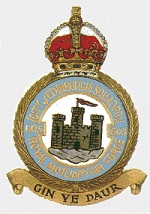Hobby Master HA7814 RAF Supermarine Spitfire Mk. I Fighter - Flg. Off. Richard Hillary, No.603 Squadron, Hornchurch, England, 1940 (1:48 Scale)
"Gin ye daur"("If you dare")
- Motto of No.603 Squadron
 The Spitfire is the most famous British aircraft of all time. Although less numerous than the Hawker Hurricane, it is remembered as the sleek, thoroughbred fighting machine that turned the tide during the Battle of Britain. The Spitfire was among the fastest and most maneuverable prop-driven fighters of World War II, serving in virtually every combat theater.
The Spitfire is the most famous British aircraft of all time. Although less numerous than the Hawker Hurricane, it is remembered as the sleek, thoroughbred fighting machine that turned the tide during the Battle of Britain. The Spitfire was among the fastest and most maneuverable prop-driven fighters of World War II, serving in virtually every combat theater.
Supermarine designer Reginald Mitchell created this small, graceful, elliptical-wing fighter with eight guns in the wings that were able to fire without being hindered by the propeller. The immortal Spitfire thus became not merely one of the best-performing fighters of all time, but also one of the best-looking. Although never employed as a long-range escort, the Spitfire was a champion in an air-to-air duel. Spitfires routinely dived at the speed of sound, faster than any of the German jets.
A carrier-based version, called the Seafire, was a winner in its own right, serving valiantly on convoy routes during World War II. The Seafire 47 was even used in the early stages of the Korean War, before it was replaced by more modern jet aircraft.
Pictured here is a 1:48 scale replica of a Supermarine Spitfire Mk. I fighter that was piloted by Flight Officer Richard Hillary, who was attached to No.603 Squadron, then deployed to Hornchurch, England, during 1940.
Sold Out!
Dimensions:
Wingspan: 9-inches
Length: 7-1/2-inches
Release Date: February 2018
 Historical Account: "If You Dare" - No.603 (City of Edinburgh) Squadron is a squadron of the Royal Auxiliary Air Force, based in Edinburgh, Scotland.
Historical Account: "If You Dare" - No.603 (City of Edinburgh) Squadron is a squadron of the Royal Auxiliary Air Force, based in Edinburgh, Scotland.
In August 1939, the squadron began to transition to Spitfires. As war approached the squadron was put on a full-time footing, and within two weeks of the outbreak of the Second World War, Carbury was permanently attached and the squadron began to receive Spitfires, passing on its Gladiators to other squadrons during October.
Scotland was in range of Nazi Germany's long-range bombers and reconnaissance aircraft. The Luftwaffe's main operations being mainly against the Royal Naval Home Fleet anchored in Scapa Flow. The squadron was operational with Spitfires in time to intercept the first German air raid on the British Isles on October 16th, when it shot down a Junkers Ju-88 bomber into the Firth of Forth north of Port Seton - the first enemy aircraft to be shot down over Great Britain since 1918, and the first RAF victory in the Second World War. It remained on defensive duties in Scotland until August 27th, 1940, when it moved on rotation to Southern England, based with No 11 Group at RAF Hornchurch, where it was operational from 27 August 1940 for the remaining months of the Battle of Britain.
Two days after the squadron became operational in southern England, Carbury claimed the first of his 15-1/2- victories, becoming the fifth highest scoring fighter ace of the battle. He was awarded the Distinguished Flying Cross and Bar with 603 Squadron during the battle. P/O R. 'Rasp' Berry claimed some nine (of an eventual total of 17) victories during this time, while P/O 'Sheep' Gilroy claimed over six victories. Plt Off Richard Hillary (five victories) was shot down on September 3rd in combat with Bf 109's of Jagdgeschwader 26 off Margate at 10:04hrs - rescued by the Margate lifeboat, he was severely burned and spent the next three years in hospital, during which time he wrote a book, The Last Enemy. By the end of the Battle of Britain, according to more recent academic research including the scrutiny of German records, 603 Squadron were identified as the highest-scoring Battle of Britain fighter squadron.
Returning to Scotland at the end of December, Carbury damaged a Ju 88 on Christmas Day over St Abb's Head, before leaving squadron in January 1941 as an instructor at the Central Flying School. In May 1941, the squadron moved south again to take part in sweeps over France (termed "Rhubarb's"), until the end of the year.
After a further spell in Scotland, No.603 left in April 1942 for the Middle East where its ground echelon arrived early in June. Concurrently, Flt Sgt Joe Dalley moved from the squadron to PRU duties and flew a Spitfire PR direct from RAF Benson to Malta, joining 69 Squadron to become one of four pilots known as the "Eyes and Ears" on the Island. The squadron's aircraft were embarked on the US carrier Wasp and flown off to Malta on April 20th to reinforce the fighter defendses of the beleaguered island. After nearly four months defending Malta, the remaining pilots and aircraft were absorbed by 229 Squadron on August 3rd, 1942.





 Spitfire Model
Spitfire Model 


